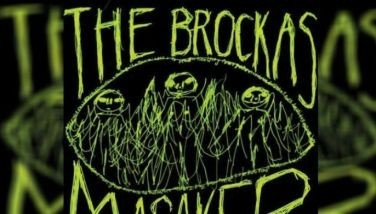The best part of being Armando Goyena
MANILA, Philippines - Veteran actor Armando Goyena passed away Wednesday afternoon (March 9). He was 88.
What do I remember about my last personal encounter with the Mr. Goyena?
Flashback late ’90s.
In a roomful of actors and movie scribes, Armando Goyena cut a dignified figure amidst the spirited debate on the pros and cons of live-in relationships.
He came from a generation where marriage was the only choice. Unbelievably during his lifetime, he was a living example that marriage could be both fulfilling and, to a large extent, incredibly durable.
The actor spoke of a more than 50-year-old marriage, eight children (seven girls and a boy) and some 28 grandchildren. “I cannot see myself having children outside of my marriage,” he had said once. “I can assure you that there is no Armando Goyena Jr. outside of my marriage.”
In his movie, Pagdating ng Panahon, produced by Gribaldi International, Goyena played the patriarch who saw nothing good for his son (played by Eric Quizon) being involved in a live-in arrangement. “The role was every inch the real Armando Goyena because I come from a generation that holds a marital relationship sacred,” said the actor.
 Receiving a FAMAS award for Best Actor (not Best Supporting Actor as earlier reported) for Regal Films’ Yamashita: Tiger’s Treasure, his last movie in the late ’90s, with Lorna Tolentino (Best Actress for Abakada… Ina) and Jiro Manio, Best Child Actor for Bagong Buwan.
Receiving a FAMAS award for Best Actor (not Best Supporting Actor as earlier reported) for Regal Films’ Yamashita: Tiger’s Treasure, his last movie in the late ’90s, with Lorna Tolentino (Best Actress for Abakada… Ina) and Jiro Manio, Best Child Actor for Bagong Buwan. Eric, the director, clearly represented the other generation’s point of view.
No one in that crowd had the nerve to verbalize it but there was Eric admitting to one and all he was a product of a live-in love partnership and had in fact came to terms with the social bias that comes with being a product of such a union. “There was a time when I’d be curious why I was being referred to in school as anak sa labas (illegitimate child),” said Eric, “I’d find out why it was so but even if that is a socially unacceptable union then, I also know that without that live-in relationship between my mother and my father, I would not be ushered into this world.”
Pagdating ng Panahon explored such a relationship with Aiko Melendez playing the other half of a coming together without the benefit of marriage. This role she considered was one of her rites of passage to reel and real-life adulthood.
In this screen exploration of love relationships and the choices open to people young and old alike, where did a film institution like Armando Goyena come in?
For producer-actor-director Eric, Goyena wasn’t just the actor but a living symbol of the good things that come out of a durable marriage.
“One thing I like about Armando Goyena is that he is so cool,” he said “He had this confidence which was neither yabang (pride) nor arrogance and which made him perfect for the role. I also like his simplicity. As you can see, he is also a gentleman of the first order.”
Even non-showbiz people who saw him take the stairs to the function room for the noonday presscon could only agree with the observation.
In a long-sleeved shirt covered by a bluish coat the color of his pants, Goyena exuded what was good about his era: The gentility of old-world charm and a quiet dignity that often eluded even noted movie personalities.
When you discover that his acting started with the play of Wilfredo Ma. Guerrero (Wanted: A Chaperone) and then moved on to Bert Avellana who directed him in a Tenessee Williams starrer (Summer and Smoke) and on to a Nick Joaquin warhorse (as Tony Javier in Portrait of the Filipino As An Artist), you realize that here was a man who combined the best of both the challenges of film and theater.
Indeed the call of acting started when he was still managing a department store in 1945 and he bumped into Wilfredo Ma. Guerrero (National Artist for Theater) in the coffee shop. He told him he was writing a play and he wanted him to appear in it. He accepted with the rehearsals starting on a weekend and finally opening in another weekend.
The venue was the open field of a veteran’s hospital (the play was a fund-raising event for wounded soldiers of the last war). Just before curtain time, he peeped into the curtain separating the stage from the audience and saw the huge turnout of the crowd. He got cold feet. He told Guerrero he could not do it. He was in the act of making a disappearance when the playwright-director literally pushed him on stage to signal the start of the play.
“On my first line and on to the second line, I got no reaction,” he recalls. “But on my third line (a laugh line), I heard the crowd let out a mass laughter and from then on, they were at the tip of my hands. I had all the laughs and that was the start of my theater invasion as I started to appear in one play after another. Indeed, the stage is the best place to learn acting. You have a direct communication with the audience and from the way they react, you can tell if you are doing well or you are laying an egg. My stage experience was an asset when I finally entered the movies.”
 In an early movie for LVN Pictures with his perennial leading lady Tessie Quintana.
In an early movie for LVN Pictures with his perennial leading lady Tessie Quintana. For two years, Goyena received just enough for his transportation as the proceeds of the theater production was for charity. “If the gate (ticket sales) was good, we ended up in a panciteria. But if it is not good, we only have enough for siopao and siomai.”
His first movie attempt was when he approached then film matriarch Doña Sisang (Doña Narcisa de Leon of LVN Films) and asked her if he could be a movie star. She told him to wait and for two months. He did not hear from her.
The movie circa 1948 made money and three and four other films later, the Armando Goyena-Tessie Quintana loveteam was born.
Over a 10-year period, he made movies the memorable ones of which were Misteryoso, Kapitan Kidlat (with a sequel) and Hawayana (co-produced with an Indonesian film outfit).
It was the movie decade dominated by Magalona, Rogelio de la Rosa and Pempe Padilla.
One movie he did which was similar to the Mrs. Doubtfire role of Robin Williams was the movie Tiya Loleng done in 1950. In the movie, he was not allowed to see his screen lover Tessie Quintana because the father was very strict. To enable him to see her every day, he disguised himself as Tiya Loleng. One time, the father got curious about Tiya Loleng who was invited to watch the movie with father and daughter. “The father was seated between me and Tessie Quintana and there is a scene where her father fell in love with him (as Tiya Loleng) and had his hands on his knees during the screening. I died laughing doing that part,” he recalled.
But how was showbiz in the last ‘40s and in the middle ‘50s when he peaked as a star?
At the time, presscons were limited to three or four writers (from Kislap and Song Movie Magazine, etc.). Interviewers had to make an appointment with the studio which decided the time and place. The first movie writer to interview him was the late Ernie Evora Sioco.
The big three during his time were LVN Films, Sampaguita Studios and Premiere Films. “When you are with LVN at the time, you couldn’t cross over to Sampaguita or Premiere except with prior arrangement with the mother studio,” he points out.
Contract stars were treated like members of a family. Neophytes were given acting lessons and tips on social graces. There were no stuntmen, no doubles. Actors reported on time the way employees reported promptly for an eight-to-five job.
They could not choose roles. The mother studio assigned them.
Action pictures were mostly about Japanese atrocities. Movies about bandits and underworld characters were also unheard of (until Ramon Revilla discovered their box-office potential).
Goyena had this to say about the latter day action pictures in the country: “Now they destroy more cars and burn a lot of houses and spend a fortune on several rounds of ammunitions to make action pictures. In my time, there were more choices. Action pictures revolved around guerilla exploits but you also have comedy, you have costume pictures and there were musicals.”
Showbiz intrigues were unheard of during his time but rumors about this and that actor could sometimes be hilarious rather than scandalous. “One time, it was rumored that my wife was after Tessie Quintana who was associated with the Goyena-Quintana loveteam. People who knew us better dismissed the rumor as simply unfounded.”
Because his wife never even interfered with his movie career, she didn’t even watch shootings. She knew being part of a love team was just a reel scenario. “I just had to tell her that this is my job and I had to do what I had to do.”
In 1957 after 10 years in the movies, he did his last movie (Casa Grande) to work in a credit-card company of businessman Alfonso Yuchengco (big boss of Grepalife and Philippine ambassador to Japan).
He was already managing a finance company when Avellana asked him to play Tony Javier once again in the film version of Joaquin’s Portrait of the Filipino As an Artist. “My request to appear in that one movie was turned down as the management thought it would get in the way of my job as financial manager. I begged and said, ‘Just this one movie’, but to no avail.”
The role went to Conrad Parham who he thought played the part quite real. “As Tony Javier in that play,” he said, “I carved for myself the role of a magnificent heel promising the moon and stars to the love-struck Marasigan sister.”
He literally begged to appear in that movie because he was the first Tony Javier of Nick Joaquin’s classic Portrait. He must have played the part some 80 times over the years in between his LVN Films.
“I played that role as Tony Javier, not as Armando Goyena,” he recalled. Director Avellana watched him almost every night and he got compliments like “You know, you did something new tonight with that role.” That’s how much he loved the role, not the person.
He never got to see Portrait in its Filipino version with the Tony Javier of Phillip Salvador, among others. He saw Portrait The Musical and was stunned to find the part reduced to a singing Tony Javier played by Ricky Davao. “He couldn’t squeeze anything from the role because the singing was getting in the way.”
Born Dec. 7 88 years ago as Jose “Pinggoy” Revilla, Armando Goyena reflected on his marriage and career with the fulfillment of a self-made man.
He loved reading bestsellers, he was a fan of Barbra Streisand and Vicki Carre, he listens to the three tenors sing love songs (but not the operatic arias, please).
If he had to write his autobiography, he would probably zero in on his movie life, his family life and his eight wonderful children.
“I suppose I did all right as an actor but I don’t think I underwent a lot of transformations. My acting is the same as before but maybe I improved a little because of experience. What I should have done before for lack of experience I can do now. The thing is, I always read the entire script, study not only my line but also the whole story and I see how I fit in it.”
His frustration was that he never got to play other roles he wanted. “Like I wanted to play the part of a farmer and I was always told hindi bagay sa’yo.” But looking young also had its advantage. When I was 28, I could play the part of a 19-year-olds because they said I didn’t look my age at the time.”
He was proud of his marriage although he admitted he went through his share of marital trials and tribulations.
He loved his wife (Paquita Roces) all his life but never went through the rituals of flowers come Valentine’s Day. “I sent her chocolates but not flowers because I thought Valentine’s Day (like Father’s Day and Mother’s Day) were American rackets intended to promote cards.”
More than 56 years of marriage had given him the authority to say what makes it work and last a lifetime. “First of all, there has to be love. If it’s just physical attraction, that won’t last. Of course, I follow this old advice on give and take.”
So what was the best part of being Armando Goyena?
“What can I say? I was lucky to be Armando Goyena. The best part is that you are known. I never needed a calling card when I was working even outside of showbiz.”
And yet for all that he has achieved, the man would beg off from making grand pronouncements.
He said he had simple likes and dislikes, he had managed to separate his movie life and his private life.
After hearing him pour out his life and times, one could only say, “What a Guy,”
Which is the title of a one-man play he did for Wilfredo Ma. Guerrero many years ago.
(NOTE: Armando Goyena’s remains will be cremated this afternoon after the 2 o’clock funeral Mass at the Santuario de San Antonio in Forbes Park, Makati City where the wake was held.)
- Latest
- Trending


































